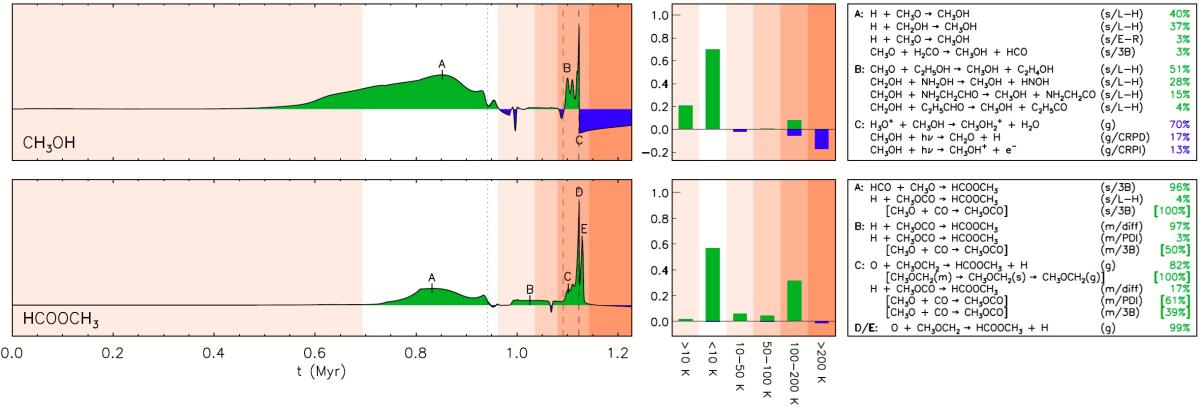The Garrod group specializes in chemical simulations of star-forming regions, using coupled gas-phase and dust grain-surface kinetics models. Our group uses our own three-phase chemical model called MAGICKAL (Model for Astrophysical Gas and Ice Chemical Kinetics And Layering), which can distinguish between the surface layer and the bulk phase of the ice that forms on microscopic dust-grain surfaces. We have developed some of the most advanced chemical networks in use to simulate the production of highly complex interstellar organic molecules. We apply these to physical conditions and dynamical treatments representative of high- and low-mass star forming cores, commonly known as hot cores and hot corinos, respectively.

Our most recent updates to the MAGICKAL modeling platform include the development and application of a comprehensive mathematical framework to simulate non-diffusive reactions on dust grains. Much of the surface chemistry taking place on interstellar dust-grain surfaces involves the diffusion of reactive chemical species, chiefly atomic H; however, reactions between immobile species may also occur on occasion, when potential reactants are deposited or formed in close proximity. Typical/traditional gas-grain astrochemical models do not include such effects. MAGICKAL allows reactive meetings to occur on the dust-grain/ice surface and in the bulk-ice mantles through diffusion (Langmuir-Hinshelwood mechanism), as well the non-diffuse processes of direct adsorption (Eley-Rideal), three-body reactions (3B, i.e. initiating reaction + follow-on reaction), and photodissociation-induced reactions (PDI, i.e. immediate reaction of photoproducts with nearby species). The full modeling treatments can be found in Jin et al. (2020) and Garrod et al. (2022). The inclusion of non-diffusive reaction mechanisms allows for the production of so-called complex organic molecules (COMs), on dust-grain surfaces, even at very low temperatures (<10 K). The products of these reactions are retained in interstellar ices until the star-formation process leads to their desorption into the gas phase (where they are most commonly detected, via rotational emission spectroscopy).

The figure above (based on Fig. 13 of Garrod et al. 2022) shows the net production rates of methanol (top) and methyl formate (bottom), during the cold-collapse stage (left of the dotted line in the left panel) and warm-up stage of a hot core (right of the dotted line). The key production and destruction mechanisms are also noted. Both species show strong net formation peaks during the cold collapse (denoted "A" in both panels). While the cold production of grain-surface methanol is a common feature of gas-grain chemical simulations (via repetitive H-atom addition to CO), the cold production of methyl formate, a commonly detected COM, requires non-diffusive chemistry for its formation (here, through the addition of intermediate radicals HCO and CH3O that would otherwise go on to form methanol).
Our group has a long-standing collaboration with observers and spectroscopists at the Max Planck Institute for Radiastronomy (Bonn, Germany), and the University of Cologne. In Garrod et al. (2017) we investigated the production of interstellar branched carbon-chain molecules, such as iso-propyl cyanide (i-C3H7CN), by the development of a chemical network that includes both normal- and iso-propyl cyanide, as well as all four propyl cyanide isomers (C4H9CN), along with associated species (see image below). Iso-propyl cyanide (i-C3H7CN) was detected for the first time in interstellar space (Belloche et al. 2014, Science) toward the Galactic Center high-mass star-forming region Sagittarius B2(N). The detection was made as a result of the EMoCA (Exploring Molecular Complexity with ALMA) survey, which is an unbiased molecular line survey of Sgr B2(N) in ALMA band 3 (~3mm). This was the first time a branched aliphatic molecule had been detected anywhere in the interstellar medium. The branched iso-propyl cyanide (i-C3H7CN) was found to be highly abundant with respect to its straight-chain isomer, normal-propyl cyanide (n-C3H7CN), with a ratio i:n = 0.40. Butyl cyanide remains to be detected in the interstellar medium.

As part of the ReMoCA molecular line survey, the follow-up to EMoCA, we detected both normal- and iso-propanol (C3H7OH) toward Sgr B2(N) (Belloche et al. 2022), with a ratio i:n = 0.6. Thus, a similar fraction of branched to non-branched molecule is revealed in both propanol and propyl cyanide.
The EMoCA survey provided the first interstellar detection and chemical modeling of N-methyl formamide (CH3NHCHO) using new spectroscopic data (Belloche et al. 2017), while ReMoCA also produced the first confirmed detection of interstellar urea (NH2CONH2, Belloche et al. 2019).
